Collaboration techniques in underground metal, such as remote recording and effective communication tools, empower musicians to create together despite geographical barriers. Key platforms like BandLab and Reaper facilitate seamless audio integration, while tools like Zoom and Dropbox enhance real-time discussions and file sharing. Addressing challenges like communication barriers and scheduling conflicts is essential for maintaining creativity and productivity in remote settings. Understanding regional preferences for collaboration tools can further optimize the creative process within the genre.
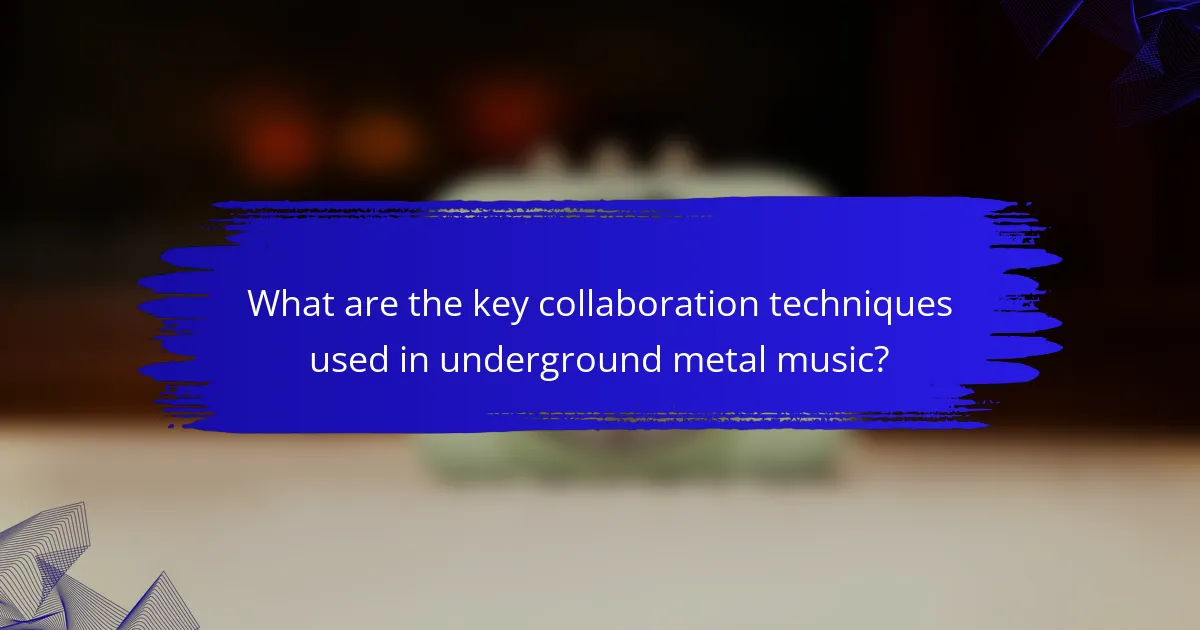
What are the key collaboration techniques used in underground metal music?
Key collaboration techniques in underground metal music include remote recording and effective communication tools. These methods enable musicians to work together regardless of geographical barriers.
Remote recording allows band members to contribute from different locations, using digital audio workstations for seamless integration. Tools like Zoom facilitate real-time discussions, while platforms such as Dropbox or Google Drive streamline file sharing.
Additionally, social media fosters community engagement, allowing artists to collaborate on projects and promote their music. These techniques enhance creativity and efficiency in the underground metal scene.
How do remote recording tools enhance collaboration among musicians?
Remote recording tools significantly enhance collaboration among musicians by enabling seamless communication and real-time feedback. These tools allow artists to share high-quality audio tracks instantly, regardless of their geographical locations. This flexibility fosters creativity and innovation, as musicians can experiment with ideas without the constraints of physical presence. Additionally, features like video conferencing and chat functions facilitate constructive discussions about musical arrangements and production techniques. By integrating these remote tools, underground metal bands can maintain their artistic vision while collaborating effectively across distances.
What role do communication tools play in the creative process?
Communication tools are essential in the creative process of underground metal, enabling collaboration across distances. They facilitate real-time feedback, enhance idea sharing, and streamline project management. Tools like video conferencing and cloud storage allow musicians to record remotely while maintaining cohesion in their sound. This adaptability fosters creativity and innovation, crucial for the genre’s evolution.
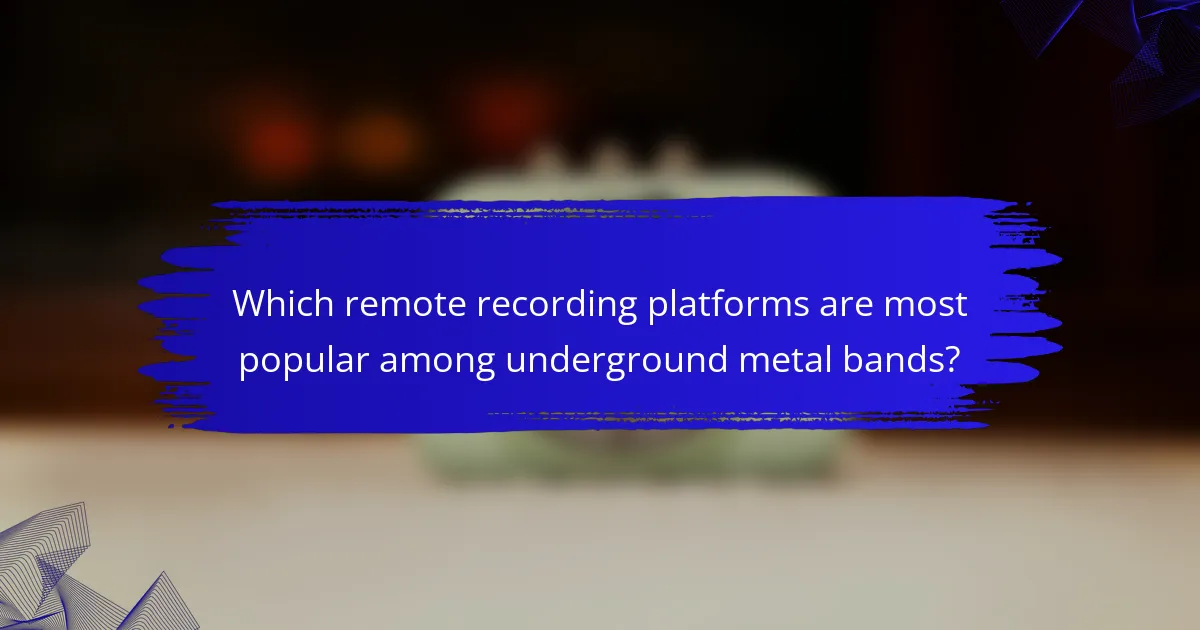
Which remote recording platforms are most popular among underground metal bands?
The most popular remote recording platforms among underground metal bands include BandLab, Soundtrap, and Reaper. These tools facilitate collaboration and communication across distances, enabling musicians to create and share music effectively.
BandLab offers a user-friendly interface and cloud storage, allowing seamless collaboration. Soundtrap provides integrated tools for recording and editing, enhancing the creative process. Reaper is favoured for its extensive customisation options and affordability, making it a preferred choice for serious musicians.
These platforms support various recording techniques and workflows, catering to the unique needs of underground metal bands.
How do features of these platforms cater to the needs of metal musicians?
Remote recording and communication tools effectively cater to the needs of metal musicians by facilitating collaboration across distances. These platforms offer features like high-quality audio streaming, which ensures that intricate details of metal music are preserved during recording sessions. Additionally, they provide real-time feedback capabilities, allowing musicians to make immediate adjustments and maintain creative momentum.
Many platforms include integrated project management tools, which help organise tasks and timelines, ensuring that all members stay aligned on goals. Furthermore, file-sharing capabilities enable easy distribution of large audio files, accommodating the extensive data typically associated with metal recordings.
Unique attributes such as customisable audio settings allow musicians to tailor their recording environment, enhancing the overall sound quality. As a result, these features collectively support the collaborative spirit essential to the underground metal scene, enabling musicians to work together seamlessly, regardless of location.
What are the advantages of using cloud-based recording solutions?
Cloud-based recording solutions enhance collaboration in underground metal by enabling seamless remote recording and communication. These tools provide real-time access to shared projects, allowing musicians to collaborate from different locations.
Key advantages include improved flexibility, as artists can work on tracks at their convenience. Additionally, cloud solutions often offer high-quality audio storage and easy sharing capabilities. They also facilitate version control, ensuring that all collaborators can track changes and updates efficiently.
Security measures in cloud services protect creative work from unauthorised access, while scalability allows teams to adjust their storage needs as projects evolve. Overall, these solutions streamline the creative process and foster innovative collaboration among underground metal musicians.
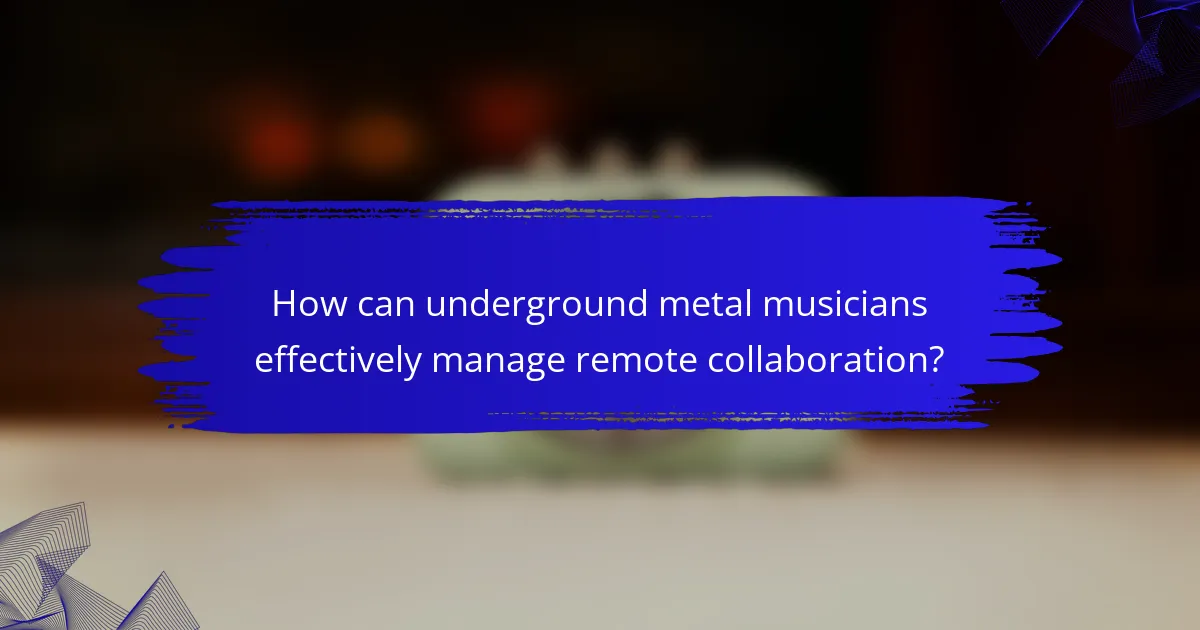
How can underground metal musicians effectively manage remote collaboration?
Underground metal musicians can effectively manage remote collaboration by utilising specific recording and communication tools. Essential techniques include using digital audio workstations (DAWs) for seamless audio sharing, employing cloud storage services for file management, and leveraging communication platforms for real-time discussions.
Utilising DAWs like Pro Tools or Reaper allows musicians to record, edit, and share tracks efficiently. Cloud storage options, such as Google Drive or Dropbox, facilitate easy access to files and collaboration on projects. Communication tools like Zoom or Discord enable musicians to hold virtual rehearsals and brainstorming sessions, fostering creativity and maintaining a cohesive sound.
Establishing clear workflows and deadlines enhances productivity in remote settings. Regular check-ins and updates ensure all members stay aligned with the project’s vision. Emphasising flexibility and open communication helps navigate challenges that arise from remote collaboration, ultimately strengthening the band’s dynamic and output.
What strategies can be employed to maintain musical cohesion?
To maintain musical cohesion in underground metal, utilise collaboration techniques that enhance remote recording and communication. Effective tools include digital audio workstations, cloud storage for file sharing, and video conferencing for real-time discussions. These methods foster creativity and ensure alignment on artistic vision. Regular feedback loops through shared platforms support ongoing collaboration and cohesion among band members.
How do time zone differences impact collaboration?
Time zone differences can hinder collaboration by creating scheduling challenges. Coordinating remote recording sessions across various time zones requires careful planning to ensure all members can participate. Utilising asynchronous communication tools like email or project management software can help bridge these gaps. Effective strategies include setting a standard time for meetings and using shared calendars to visualise time zone impacts. These techniques enhance collaboration efficiency and minimise potential conflicts.
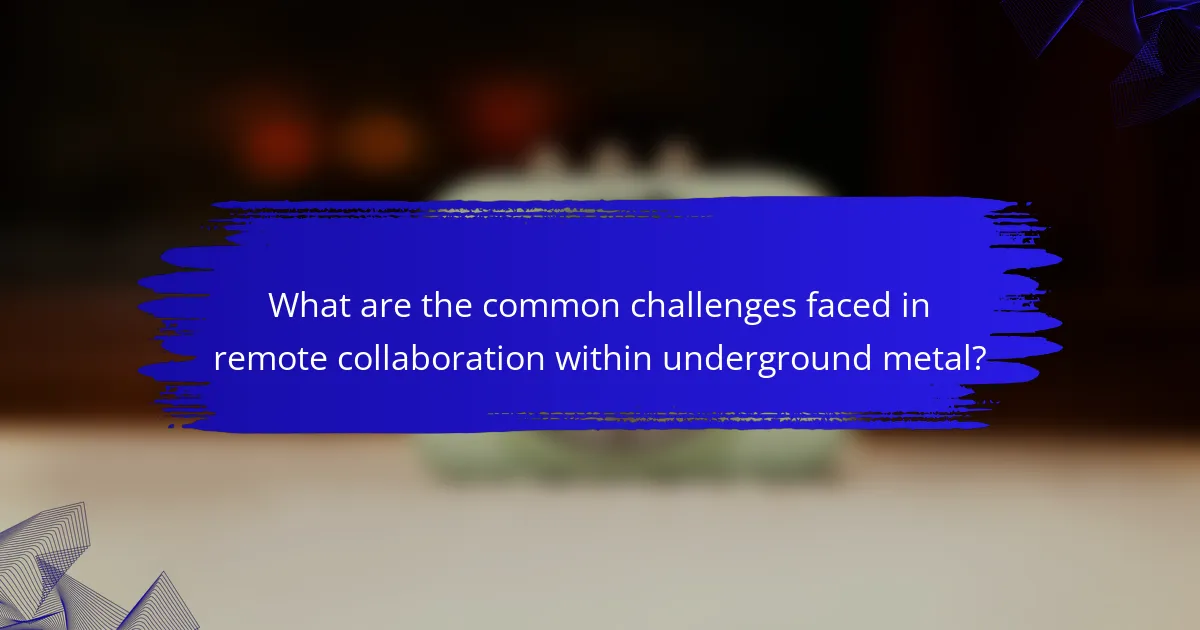
What are the common challenges faced in remote collaboration within underground metal?
Remote collaboration in underground metal often faces issues such as communication barriers, technology limitations, and scheduling conflicts. These challenges hinder effective teamwork and creative processes.
Communication barriers arise from varying interpretations of musical ideas and styles. Technology limitations can include inadequate software or hardware for remote recording, impacting sound quality. Scheduling conflicts frequently occur due to different time zones, making coordination difficult.
Additionally, the lack of immediate feedback during collaboration can stifle creativity. Overcoming these challenges requires careful planning and the use of dedicated collaboration tools tailored for musicians.
How can technical issues be resolved during remote sessions?
Technical issues during remote sessions can be resolved by ensuring proper setup, communication, and troubleshooting. First, test all equipment and software before the session starts. Use reliable recording and communication tools designed for collaboration in music production. If issues arise, maintain open lines of communication to identify problems quickly. Common solutions include restarting software, checking internet connections, and consulting user manuals or online support resources.
What are the best practices for overcoming creative differences?
To overcome creative differences in underground metal collaboration, prioritise open communication and mutual respect. Utilise remote recording tools to facilitate real-time feedback and share ideas seamlessly. Establish clear roles and responsibilities to minimise conflicts. Schedule regular check-ins to address any concerns promptly. Embrace diverse perspectives to enhance creativity and innovation.
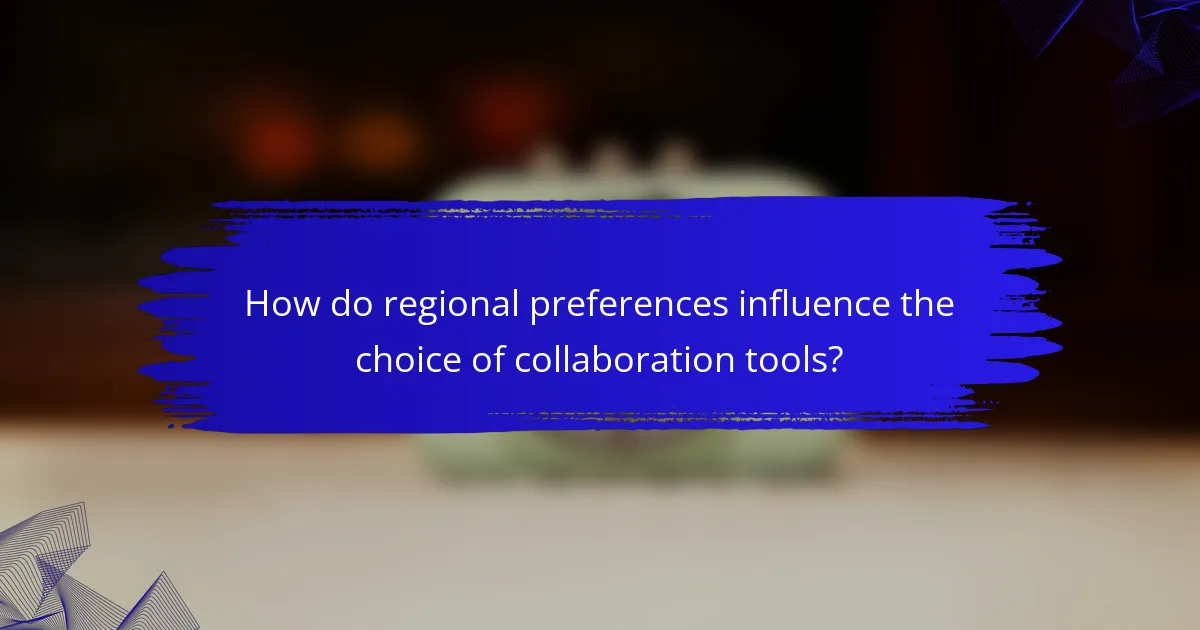
How do regional preferences influence the choice of collaboration tools?
Regional preferences significantly shape the selection of collaboration tools in underground metal. Local music scenes often dictate the tools that resonate best with musicians. For instance, in Europe, tools like Reaper and Pro Tools are favoured for their robust features and compatibility with diverse recording environments. In contrast, North American artists may prefer simpler platforms like Zoom or Skype for remote communication, reflecting a more casual approach. Cultural nuances also play a role; regions with strong DIY ethics may gravitate towards open-source tools, while others may prioritise mainstream software. These preferences ultimately influence collaboration effectiveness and creativity within the genre.
What unique attributes do Canadian underground metal bands look for in tools?
Canadian underground metal bands prioritise tools that enhance collaboration and creativity. Key unique attributes include intuitive interfaces, low-latency performance, and compatibility with various recording software. These features facilitate seamless remote recording and effective communication, essential for maintaining artistic integrity and cohesion during collaborative projects. Additionally, some bands value tools that offer high-quality audio processing and versatile connectivity options, ensuring flexibility in diverse recording environments.
How do UK bands adapt their collaboration techniques to local audiences?
UK bands adapt their collaboration techniques by utilising remote recording and communication tools to connect with local audiences effectively. These tools enhance creativity and streamline the music production process.
Remote recording allows musicians to contribute from different locations, accommodating varying schedules and geographical constraints. Software like Zoom and Discord facilitates real-time communication, enabling bands to share ideas and feedback instantly.
Additionally, platforms such as Soundtrap and BandLab support collaborative songwriting and recording, fostering a sense of community among local musicians. These methods cater to the unique preferences of UK audiences, who value authenticity and innovation in underground metal.
By embracing technology, UK bands not only maintain artistic integrity but also expand their reach, ensuring their music resonates with local fans.
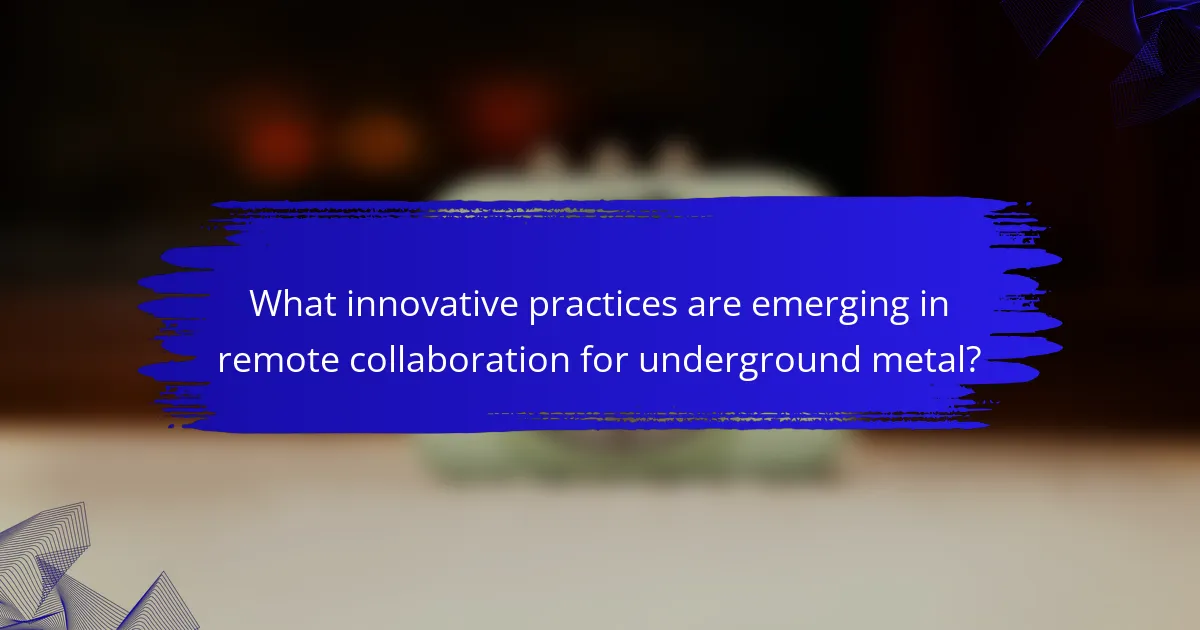
What innovative practices are emerging in remote collaboration for underground metal?
Innovative practices in remote collaboration for underground metal include utilising advanced communication tools and remote recording technologies. Tools like virtual audio workstations enable musicians to collaborate in real-time, enhancing creativity and efficiency. Cloud-based platforms allow for seamless file sharing and project management, which streamlines the creative process. Additionally, video conferencing tools foster real-time discussions, ensuring that artistic vision aligns across distances. These developments reflect a growing trend towards flexible and collaborative music-making environments.
How are virtual reality and augmented reality being utilized for creative sessions?
Virtual reality and augmented reality enhance creative sessions by facilitating immersive collaboration. These technologies allow musicians to interact in virtual environments, overcoming geographical barriers. For instance, virtual reality platforms enable real-time jamming and recording, while augmented reality tools provide visual aids for composition and arrangement. This integration fosters innovation, enhances communication, and streamlines the creative process in remote settings.
What role does social media play in fostering collaboration?
Social media significantly enhances collaboration in underground metal by facilitating remote communication and sharing resources. Platforms like Facebook and Discord enable musicians to connect, exchange ideas, and collaborate on projects regardless of geographical barriers. These tools allow for real-time feedback and brainstorming, fostering a sense of community among artists. Additionally, social media serves as a vital platform for promoting collaborative works, reaching wider audiences, and building networks that can lead to future partnerships. This interconnectedness is crucial for underground metal, where traditional avenues of collaboration may be limited.
What are the future trends in remote collaboration for underground metal?
Future trends in remote collaboration for underground metal include enhanced virtual recording platforms, improved real-time communication tools, and the use of AI for music production. These advancements facilitate seamless collaboration regardless of location. Emerging technologies like virtual reality may also create immersive jam sessions, allowing musicians to interact as if they were in the same room. Additionally, cloud-based storage solutions will streamline the sharing of large audio files, making collaboration more efficient. As a result, underground metal bands can maintain creativity and productivity in a flexible environment.
What are the best practices for optimizing remote collaboration in underground metal?
To optimize remote collaboration in underground metal, focus on effective communication and technology use. Utilize high-quality recording software and platforms that support real-time collaboration, such as Zoom or Discord.
Establish clear roles and responsibilities among band members to streamline the creative process. Regular check-ins can help maintain momentum and ensure everyone is aligned on goals.
Consider using project management tools like Trello or Asana to track tasks and deadlines. This helps in organizing workflows and enhances accountability.
Lastly, foster a positive virtual environment by encouraging open feedback and creative brainstorming sessions. This can strengthen relationships and enhance the overall collaborative experience.